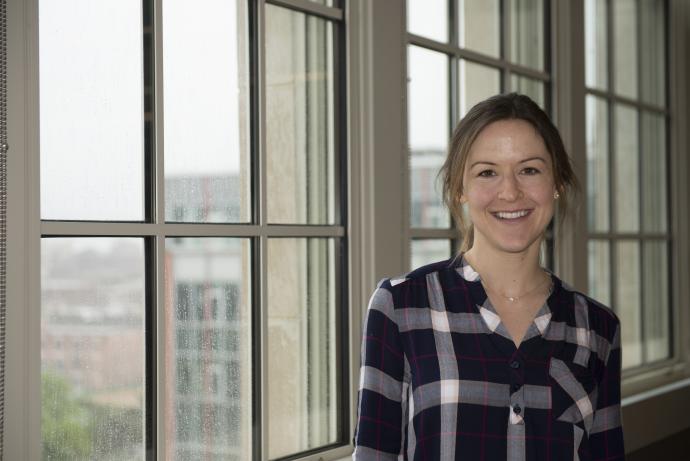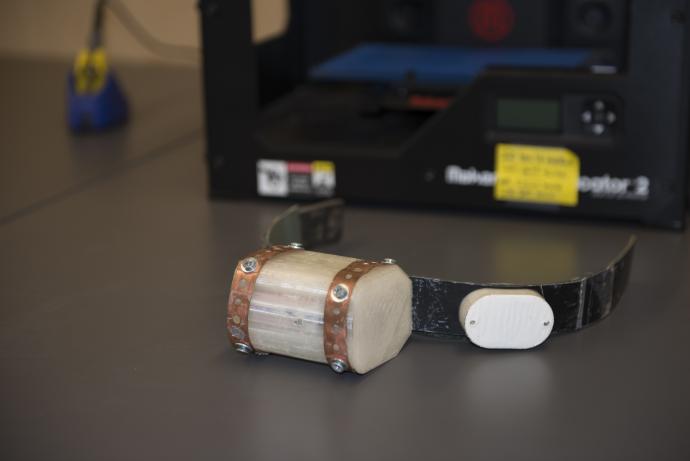NSF I-Corp Member Lisa O'Bryan Making Way With Collar Devices

(Lisa O'Bryan)
Lisa O’Bryan is an NJIT Postdoctoral researcher who’s making an impact on our understanding of how social mammals communicate within their groups. As a participant in the NSF I-Corp Program, Lisa and her team received grant funds to support customer discovery research to explore the commercial viability of their custom-made tracking devices that are aiding their study of this of this topic.
Tell us about your project.
I study the role that communication plays in collective animal behavior, particularly the role that it plays in the coordination of group-wide behavior. In order to study this topic, you need to have a lot of data on what each individual animal is doing. At the beginning of our project there were many GPS collars on the market, some even with accelerometers on them, but there was nothing at the time that had audio recording capabilities. We really needed to be able to study the vocalizations of each animal, so for my project, I’ve helped to develop a GPS collar that has audio recordings capabilities. Our collars include a GPS device, an accelerometer and an audio recorder. The GPS devices allow us to collect data on where the animals are located. The accelerometer allows us to identify their behaviors and the audio recorder allows us to study their vocalizations. Once our devices were built, we deployed them on wild baboons living in Namibia.
What inspired you to become a behavioral ecologist?
I knew I wanted to work with animals ever since I was young. Initially I thought I wanted to be a veterinarian, but I soon realized that I wanted to study wild animals. During college, I started working with Texas Parks Wildlife where I collected data on wildlife populations. I also took classes in college that were related to animal behavior. This is where I learned that researching animal behavior was a career option. I started working in a lab on campus studying vocal communication in bats. After that I applied to graduate school and continued my studies in this area.
What motivated you to create this collar device that tracked the socialization on animals?
This came out of my PHD project. I was studying chimpanzees in Tanzania, and I was using traditional observational methods where I wrote down data on their behaviors. I also recorded their vocalizations with a handheld microphone. However, this was difficult because I could only focus on one individual animal at a time. IT felt like I was missing out on a lot of information about what was happening in the rest of the group. For instance, when the individual I was focusing on was giving calls, a lot of other individuals in different areas were also giving calls. Therefore, I felt like I couldn’t capture the full dynamic of what was happening in the group. I began reading studies on the use of tracking collars for studying the locations of individual animals. I thought this was great, and I wanted to be able to add audio recording abilities to these devices.

(Collar Device)
How did you get involved with the NSF I-Corp Program?
We applied last semester when we began thinking about making our collars commercially available. We’ve been exploring this idea while also continuing to develop our devices in order to make them easier to use for other research groups. My postdoc adviser, Simon Garnier, recommended that I apply for this program because it gave us the opportunity to talk with potential customers who might be interested in using the devices we are developing.
How important was it to receive the NSF I-Corp grant? And how has it helped you achieve your goals and push your product along?
With this grant I’ve really been able to get a better idea of what the interests are of people who might want to use these devices. I’ve been talking to other researchers as well as employees at zoos and even pet owners. The NSF I-Corp Program has given me an opportunity to go out and talk to a lot of different people to get a better sense of the value of what we are developing.
Lisa is continuing to make further developments on the collars and has been working with Engineering masters students all of this semester in order to update the hardware. She also worked with a team of students in the design program at NJIT in order to create a more effective external casing. These students created the external design of the collars as an end of the semester projects. Lisa and her team are currently looking for opportunities to continue taking this project forward.
